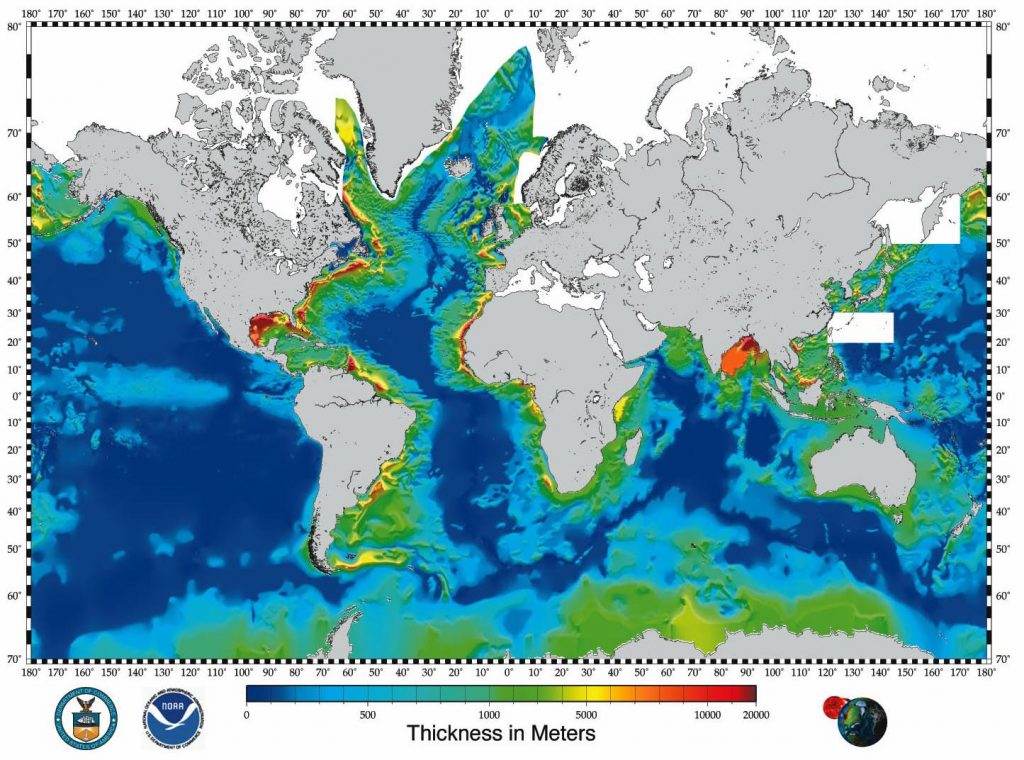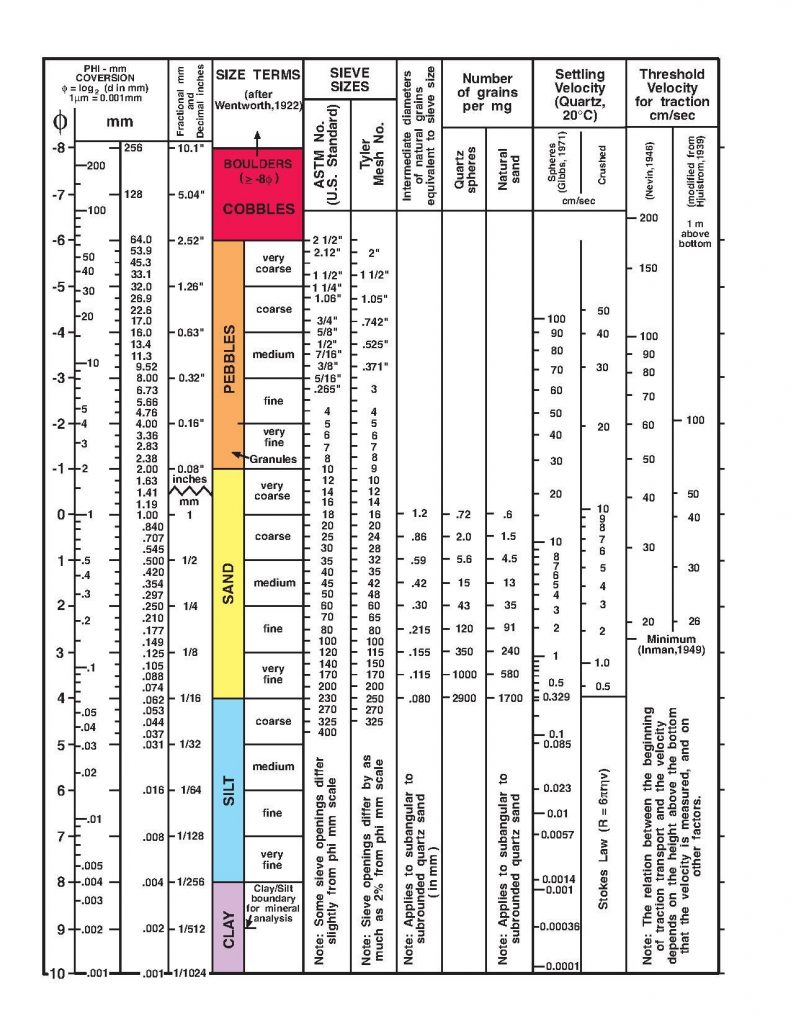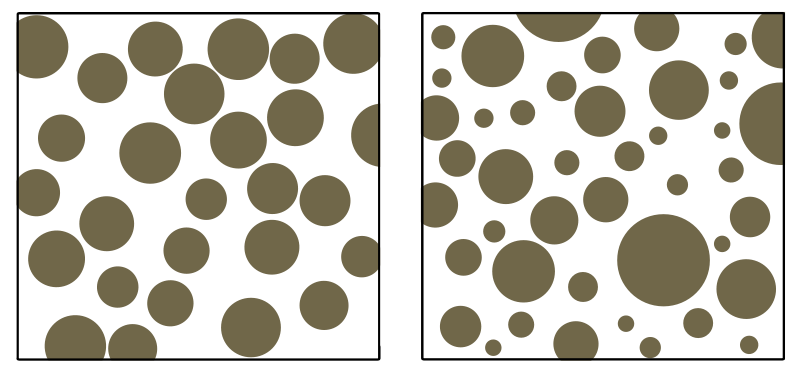12.1 Classifying Sediments
The term “sediment” refers to the tiny particles of rocks and other materials that sink to the ocean floor and eventually settle and accumulate on the bottom. All regions of the seafloor contain some form of sediment, although there are many different types of sediments from a variety of sources, and the amount of accumulated sediment can vary greatly from place to place. Globally, ocean sediments average about 1 km thick, but they can exceed 15 km thick in areas of high accumulation (Figure 12.1.1). These areas include regions near the mouths of rivers where there is high sediment discharge, and passive margins near the continents where the seafloor has had millions of years for sediment to accumulate. On the other hand, sediments are sparse along divergent plate boundaries where new oceanic crust is being formed, as the crust is too new for significant accumulation (see section 4.5), and in the central oceans that are far away from any significant sediment sources.

As time passes over millions of years, these sediments can become lithified or turned into sedimentary rock. It has been estimated that over half of the exposed rock on the continents is sedimentary rock originally deposited in ancient oceans and uplifted by plate tectonics. Many tall mountains, including Mt. Everest, are composed of rock formations that contain fossils of marine creatures. These rocks were originally formed as ocean sediments which were then lithified and pushed upwards during the process of mountain formation.
Sediment Classification
There are a number of ways that we can classify ocean sediments, and some of the most common distinctions are based on the sediment texture, the sediment composition, and the sediment’s origin.
Texture
Sediment texture can be examined through several variables. The first is grain size. Sediments are classified by particle size, ranging from the finest clays (diameter <0.004 mm) to the largest boulders (> 256 mm)(Figure 12.1.2). Among other things, grain size represents the conditions under which the sediment was deposited. High energy conditions, such as strong currents or waves, usually results in the deposition of only the larger particles as the finer ones will be carried away. Lower energy conditions will allow the smaller particles to settle out and form finer sediments.

Sorting is another way to categorize sediments. Sorting refers to how uniform the particles are in terms of size (Figure 12.1.3). If all of the particles are of a similar size, such as in beach sand, the sediment is well-sorted. If the particles are of very different sizes, the sediment is poorly sorted, such as in glacial deposits.

Finally, sediment texture can be described based on its maturity, or how long the particles have been transported by water or other vectors. Maturity can be reflected by the degree of rounding of the particles, the amount of sorting, and the composition of the sediment. In the case of rounding, the more mature the sediment, the rounder the particles, as a result of the particles being abraded over time. A high degree of sorting indicates maturity, because over time the smaller particles will be washed away, and a given amount of energy will move particles of a similar size over the same distance. Lastly, the older and more mature a sediment the higher the quartz content, at least in sediments derived from rock particles. Quartz is a common mineral in terrestrial rocks, and it is very hard and resistant to abrasion. Over time, particles made from other materials are worn away, leaving only quartz behind. Beach sand is a very mature sediment; it is composed primarily of quartz, and the particles are rounded and of similar size (well-sorted).
Sources of sediments
Sediments are also classified based on their source of origin. There are four main categories for the origin of marine sediments:
- Lithogenous sediments are derived from preexisting rock. They are also called terrigenous sediments since most of it comes from the land masses and makes its way into the ocean.
- Biogenous sediments are composed of the remains of marine organisms.
- Hydrogenous sediments are formed when materials that are dissolved in water precipitate out and form solid particles.
- Cosmogenous sediments are derived from extraterrestrial sources.
The next few sections will address each of these sediment types in more detail.
unconsolidated particles of mineral or rock that settle to the seafloor (12.1)
a boundary between a continent and an ocean at which there is no tectonic activity (e.g., the eastern edge of North America) (1.2)
a plate boundary at which the two plates are moving away from each other (4.5)
the Earth’s crust underlying the oceans (as opposed to continental crust) (3.2)
the conversion of unconsolidated sediments into rock by compaction and cementation (12.1)
the concept that the Earth’s crust and upper mantle (lithosphere) is divided into a number of plates that move independently on the surface and interact with each other at their boundaries (4.1)
sediment particle that is less than 1/256 mm in diameter (12.1)
a sediment with a grain diameter of at least 256 mm (12.1)
how uniform the particles of a sediment are in terms of size (12.1)
how long sediment particles have been transported by water or other vectors (12.1)
a mineral composed of silicon and oxygen atoms in the ratio of 1 Si:2 O; one of the most abundant minerals in the Earth's surface (12.1)

